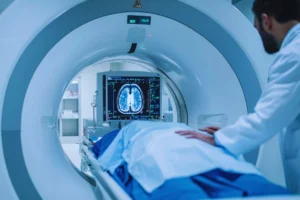Oncologic Radiology is essential for early cancer detection, leading to significantly better patient outcomes. Through advanced imaging techniques, radiologists can identify tumors at their earliest stages, often before symptoms manifest. Early detection allows for the creation of customized treatment plans. Oncologic Radiology employs tools like MRI, CT scans, and PET scans to generate detailed images of the body’s internal structures, helping oncologists accurately assess the size, location, and spread of cancer. This precise information is critical in determining the appropriate course of action, whether it’s surgery, chemotherapy, or radiotherapy radiology.
Key benefits of Oncologic Radiology in cancer detection include:
- Early Detection: Imaging techniques help identify tumors before symptoms appear.
- Detailed Imaging: Advanced techniques provide high-resolution images, aiding in accurate assessments.
- Precise Diagnosis: Radiology helps determine the exact size, location, and spread of cancer.
- Personalized Treatment Plans: Imaging results guide the creation of tailored treatment strategies.
- Collaborative Approach: Oncologists and radiologists collaborate to ensure accurate diagnosis and effective treatment planning.
With Oncologic Radiology, healthcare providers can significantly improve cancer treatment outcomes and enhance patient care by utilizing cutting-edge technology and expert analysis.
Oncologic Radiology is central to modern cancer diagnosis, offering a non-invasive method to visualize the body and detect abnormalities. Radiologists who specialize in oncology utilize various imaging modalities to identify cancerous growths, providing crucial information for developing effective treatment strategies. Here’s how Oncologic Radiology contributes to the cancer diagnosis process:
- Early Detection: Techniques like mammography and low-dose CT scans identify cancers before symptoms develop, improving the chances of successful treatment.
- Accurate Localization: PET scans and MRI pinpoint tumor locations, aiding surgical planning and radiotherapy radiology treatments.
- Cancer Staging: Imaging methods assess how far the cancer has spread, crucial for staging the disease and deciding the appropriate treatment.
- Biopsy Guidance: Imaging ensures tissue samples are taken from the right areas for more accurate diagnostic results.
- Monitoring Treatment Response: Imaging tracks how well a patient is responding to treatment, helping physicians adjust therapy as needed.
Oncologic Radiology is indispensable for diagnosing cancer and guiding effective treatment planning.
Advanced Imaging Techniques
The use of advanced imaging techniques in Oncologic Radiology is vital for detecting, diagnosing, and monitoring cancer. These sophisticated tools provide oncologists with detailed insights into tumor behavior, allowing for more precise treatment planning. Key imaging techniques used include:
- Magnetic Resonance Imaging (MRI): Provides detailed images of soft tissues, differentiating between benign and malignant tumors.
- Computed Tomography (CT) Scans: Offers a comprehensive view of the body, essential for locating tumors and assessing metastasis.
- Positron Emission Tomography (PET) Scans: Often combined with CT scans (PET/CT), this technique measures the metabolic activity of cells, helping detect cancer cells with high metabolic rates.
- Ultrasound: Utilizes sound waves to create images, particularly useful for examining soft tissues and organs.
- Digital Mammography: Critical for early breast cancer detection, offering clearer, more accurate images than traditional mammography.
These advanced imaging modalities are instrumental in improving cancer detection, tumor mapping, and monitoring treatment response, ultimately enhancing the quality of cancer care provided at Best Oncology Treatment.
Interpreting Radiological Findings
Interpreting radiological findings is a critical component of Oncologic Radiology. Radiologists analyze images from X-rays, MRIs, and CT scans to detect abnormalities, helping oncologists make informed decisions regarding patient care. Here’s how this process contributes to cancer diagnosis and treatment:
- Detection of Abnormalities: Radiologists specialize in identifying unusual masses or lesions that might indicate cancer, even in early stages.
- Accurate Diagnosis: High-resolution images help determine the size, shape, and location of tumors, which is crucial for staging and treatment planning.
- Guiding Biopsies: Radiology helps pinpoint the exact location for tissue sampling, ensuring accuracy during biopsies.
- Monitoring Treatment Progress: Radiological imaging evaluates changes in tumor size and response to treatment, offering a visual representation of the patient’s progress.
- Collaborative Care: Radiological findings are shared with oncologists to help develop personalized treatment plans.
Radiologists at Best Oncology Treatment play an essential role in turning radiological data into actionable insights, guiding targeted cancer therapies.
Treatment Planning
In oncology, Oncologic Radiology is vital for developing effective treatment strategies. The imaging techniques used provide detailed insights into tumor size, location, and behavior, helping oncologists craft the most precise treatment plans. Some key roles of radiology in treatment planning include:
- Individualized Treatment Plans: MRI and CT scans provide detailed images that enable oncologists to create treatment plans tailored to the patient’s unique needs.
- Radiotherapy Planning: Radiological imaging is used to map out the tumor, ensuring that radiation targets cancer cells while minimizing damage to healthy tissues.
- Surgical Planning: Surgeons rely on precise radiological images to plan safe and effective tumor removal procedures.
- Assessing Treatment Response: Follow-up scans monitor treatment efficacy, allowing therapy adjustments to ensure the best patient outcomes.
- Preventing Complications: Regular imaging detects changes in tumor behavior early, preventing complications and allowing for timely adjustments to treatment.
By integrating radiology into cancer treatment planning, Best Oncology Treatment enhances the precision of care, ultimately improving survival rates and quality of life for our patients.
Challenges and Innovations
Oncologic Radiology faces several challenges, which drive ongoing innovation within the field. These challenges include:
- Differentiating Conditions: Distinguishing between benign and malignant tumors using imaging alone can be difficult. Ongoing advancements in imaging techniques help provide clearer visuals.
- Early Detection: Identifying cancer at its earliest stages remains a challenge. Innovations like molecular imaging and AI technologies aim to improve early detection.
- Minimizing Radiation Exposure: Reducing patient radiation exposure is a continuous goal, with advancements in imaging protocols helping to minimize these risks while maintaining image quality.
- Technology Integration: Integrating AI and automated image analysis without disrupting existing workflows is a challenge, but critical for improving diagnostic accuracy.
- Cost and Accessibility: Innovations such as tele-radiology and portable imaging devices are making Oncologic Radiology more accessible, particularly in underserved areas.
These challenges fuel innovation, ensuring that Oncologic Radiology remains at the forefront of cancer diagnosis and treatment.

